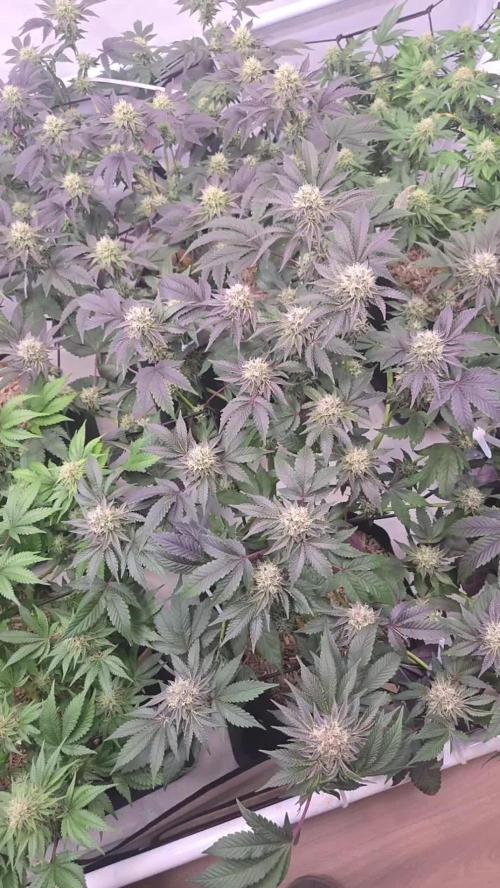The Grow Awards 2026 🏆 































Likes
Comments
Share


@NSCanna
Follow
Compost tea turned out well and if your curious about the microscopy, check the comments on my GMP grow. No signs of senescence yet so no feed needed, they are in a second run of the same soil so there should be plenty in there from before.
Not very resinous or smelly, with weird wide stumpy buds. Definitely my least fav pheno of any plant I've grown so far, but it's the end product we're after so she may yet surprise.
Likes
32
Share


@AsNoriu
Follow
Day 77. Maybe a bit early, but no space and one Smoothie went for a date with bud rot ;))) didn't want to loose that nice top. Very frosty, nice gassy smell surrounded by fruits.
Day 82. Second girl is down. Both small as you see, but with few branches will produce seed packaging cover type plant. Maybe second got some purple fade ... First was very nice by structure.
Day 85. First went to jar. How lovely it sparkles and smells !!! Solid strain, even being so small by structure.
Day 89. Second is in jars too !
Happy Growing !!!
Likes
3
Share


@S3phwaa
Follow
Working on some timelapse settings so I can have some cool development videos for my journals. Enjoy!
Does the size/height and thickness of these guys seem healthy for the 6 week age? Just want to check in with some experienced growers.
Likes
1
Share


@Farad9650
Follow
The endgame ph was messed up and the plant severely suffered from algae and possible overwatering. The Spanish moon was also damaged.
Likes
8
Share


@Growstopher
Follow
7.14.25. Finally harvested this plant! Quality of buds look pretty good even though I diminished the harvested big time by stunting her in vegetative stage and she never recovered! Wet weight of buds was only 25.7 grams. Definitely will be ordering this strain again and correct what went wrong on this grow.
Thank you for looking at grow I appreciate it! Will be back in 1-2 months with new grow!
Likes
23
Share


@Chase13852
Follow
Still having a little issue with deficiency and hoping that the top dressing takes hold soon. Getting close to finish. Possibly 3 to 4 more weeks maybe a bit more. Will be adding a top dressing schedule to my next grow after these 4 are done.
Likes
7
Share


@TJHeadley
Follow
Tempature was getting to 60° at night and 67° during lights on. Bought foam board to put under the tents and an oil space heater to combat cold temps. Defoliated on 11-6-23. Top Dressed with BuildaSoil Craft blend ¼ Cup
Likes
17
Share


@MadeInGermany
Follow
Hey guys :-)
First of all I have to say that all 5 strains I have in the tent from Amsterdam Genetic are beautiful genetics 👍 .
This week they were repotted into 8L fabric pots.
When repotting, 2 g of Green House Powder Feeding Bio line were added per liter of substrate :-) .
That's enough until the first flowers start 👍.
Watering was done twice this week with 0.8 l each.
Otherwise everything was cleaned and checked and fresh osmosis water was mixed.
Stay healthy 🙏🏻💚
👇🏼👇🏼👇🏼👇🏼👇🏼👇🏼👇🏼👇🏼👇🏼👇🏼👇🏼👇🏼
You can buy this Nutrients at :
https://shop.greenhousefeeding.com/us/
👇🏼👇🏼👇🏼👇🏼👇🏼👇🏼👇🏼👇🏼👇🏼👇🏼👇🏼👇🏼
You can buy this strain at :
https://www.amsterdamgenetics.com/product/skyrocket-feminized-cannabis-seeds/
Water 💧 💧💧
Osmosis water mixed with normal water (24 hours stale that the chlorine evaporates) to 0.2 EC. Add Cal / Mag to 0.4 Ec Ph with Organic Ph - to 5.8 - 6.4
MadeInGermany
Likes
3
Share


@MadBumbleBee
Follow
1 OG kush Shows Sings of Nitrogen Toxicity (cut most leafs off)
Soil PH: 5.7 - 6.8 (lowest and highest reading)
Flushed all plants with microrayza fungi
Watering with organic bio activated tea every 3 days (potassium = algae, bokashi = nitrogen, worm hummus and molasses)
Day 28 to 35
Day 32: Accidently cut off main stem of a very healthy OG kush plant, let´s see how it bounces back in a few days. Perhaps I just HST´d by accident
Day: 32: Some of my autoflower GSC already started to flower
Day 32: 3 OG kush plants are weak, one has a weak stem, second one had a problem since seedling (grew into the ground), third one i cut off main stem by accident
Day 34: OG kush plant was removed after many tries of getting it back to its feet
Likes
8
Share


@STAYINGONMYMAINCBATORUNTWO
Follow
Was a bit worried in the first weeks of flower as the buds formed early but... i was left with the most densest of buds literally hard like arnie in his terminator days lol! I didn’t quite get the amount I expected but defiantly enough! Will defo grow again!
After time went on she developed so much frost literally like diamonds 💎
Resistance was very strong on this one too and drank so much more than the rest had to be smart with watering! I’m the end the result was as intended can’t wait for the next couple of weeks for the flavour to really come out but as of now really reminds me of skittles as you can taste the sweetness but also that cake 🍰 comes right through too and this is before a full cure. Happy growing buddies I say this one is a top one to grow!
Added a few photos since cure! These buds are dense and colorful and fruity! Tastes like it smells until you get a lovely bit of cake come through! Heaven!
High is full body literally one point I felt it in my feet rose to my chest!
Processing
Likes
9
Share


@JerMeds
Follow
These 2 girls are looking and smelling good, canopy is almost full. I'm glad they are staying smaller and not over running my grow box.
Had to LST the first girl again. She recovered well and now fully spread out and shes finishing up stretch. She has some yellowing leafs at the bottom so I upgraded her nutrients to 5ml/gal. I will see how she reacts to it and adjust accordingly.
The second girl was just a big bundle of leafs, I took off about 10-15 big leafs, now more bud sites are exposed. (See Pictures) Maybe I can get a little bit more LTS out of her. I'm not sure she is going to stretch anymore. Time will tell.
Likes
5
Share


@Josecortez420
Follow
Started to worry about space in my tent, so flip time, especially given the fact I still have other strains that need to fit in here, only decided to document the Dos Si Dos as my other strains are either from cuttings and are very secret lol or they are seeds I received as samples.
Likes
64
Share


@SmokingTiki
Follow
The plants streched a lot this week! The flowering has started 😎 I made a last defoliation to give some light to the lower buds. I started to give some BioBloom. It's impressive how much these plants must drink, this is the first time I have to water every day!
Plants heights at the end of the week :
-------------------------------------------
Gorilla Cookies : 90cm
Purple Lemonade : 69.5cm
Wedding Cheesecake : 89cm
Likes
1
Share


@drrrt
Follow
They all got very heavy and big buds, the plant/stems do not have just a chance to support the weight of the flowers on their own.
Since I'm in lack of flower/smoke material currently, I chopped on D51 already one tree. Going to take care of the remaining in the upcoming days and will post next update once everything is dried.
Smells lemony with a taste lavender flavor, a bit like a very masculine after shave. And it's very very stinky, leave it open in the basement and you are going to smell it also on the 3rd floor of the house. Grew the clone now the second time and nailed it this time much better.
She's for sure a keeper. High yielding, fast flowering sativa like growing terp monster 🔥
Likes
101
Share


@TOTEM
Follow
Almost done here! What a journey. I’m gonna flush her tonight, even if the soil is still wet. I’m sorry I don’t have one extra week (2 weeks with Overdrive would be better), but the buds are big and fat now. Definitely time for a big flush. You can see trichomes maturation on the two videos I uploaded.
Likes
14
Share


@Hempface86
Follow
Here we are day 40 and she is doing very well.. no sign of trichome production yet but I'm hoping that happened soon.. with that being said he has been super easy from beginning to now no issues whatsoever so I I'm happy.. big shout out to Sensible Seeds for a hooking me up to be able to showcase their genetics.. if you guys want to check them out I'll have a link below.. all smiles over here hope all is doing well God bless and happy growing ✌️😎
https://www.sensibleseeds.com/

























